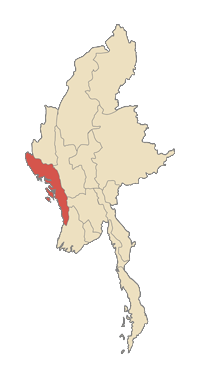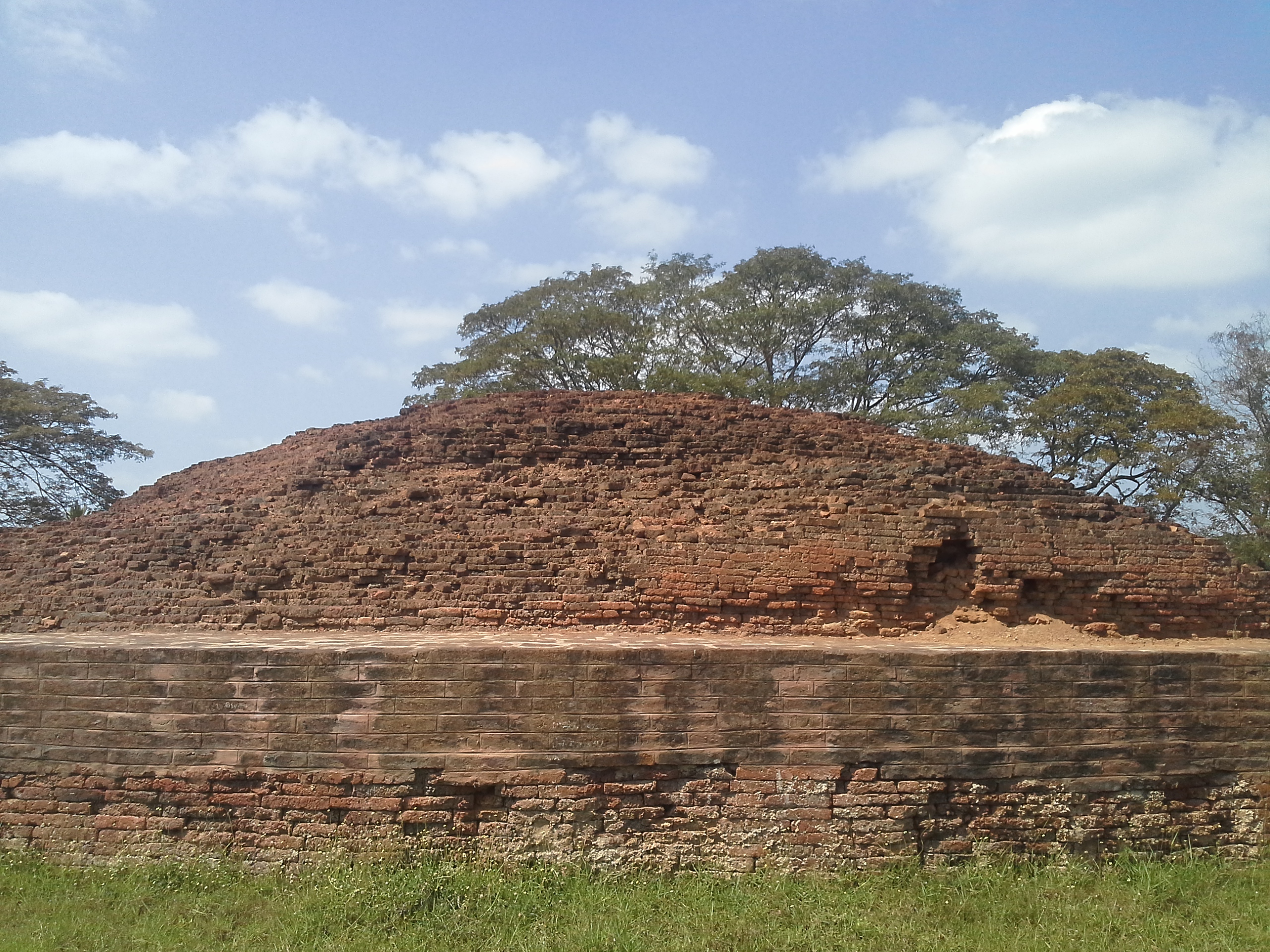|
Waithali
Waithali (, , ) located in today's northern Rakhine State, Myanmar, was the capital of the Waithali Kingdom from 370 to 818. The former capital site is approximately north-east of Sittwe, and east of Ram Chaung, a tributary of the Kaladan river. Like much of northern Rakhine State, Waithali is in a hilly locale. Like its predecessor, Dhanyawadi, the former capital site has fallen into ruin and much of it is now deserted. Only a few temples and traces of the old city wall remain. The site is about an hour's bus ride from Mrauk U. Etymology Waithali is the Burmese language pronunciation of the Pali word Vesali (). History It has been estimated that the centre of power of the Arakanese world shifted from Dhanyawadi to Waithali in the 4th century AD as Dhanyawadi Kingdom ended in 370 AD. Although it was established later than Dhanyawadi, Waithali is the most Indianized of the four Arakanese kingdoms to emerge. Like all of the Arakanese Kingdoms to emerge, the Kingdom of Waithali w ... [...More Info...] [...Related Items...] OR: [Wikipedia] [Google] [Baidu] |
History Of Rakhine
Rakhine State occupies the northern coastline of Myanmar up to the border with Bangladesh and corresponds to the historical Kingdom of Arakan. The history of Rakhine is divided into 7 parts – the independent kingdoms of Dhanyawadi, Waithali, Lemro, Kingdom of Mrauk U, Mrauk U, Burmese occupation from 1785 to 1826, British rule in Burma, British rule from 1826 to 1948 and as a part of independent Burma from 1948. From the first millennium AD, Arakan was a frontier region between India and Southeast Asia that could be accessed both by land and sea. The Arakanese Kingdom of Mrauk U, kingdom of Mrauk-U was conquered on December 31, 1784, by the Burmese Konbaung dynasty. In 1826, Arakan was ceded to the British as war reparation after the First Anglo-Burmese War. It became part of the province of Burma of British India in 1886, after the annexation of Burma by the British. Arakan became part of the Crown Colony of British rule in Burma#Burma separated from India, British Burma wh ... [...More Info...] [...Related Items...] OR: [Wikipedia] [Google] [Baidu] |
Rakhine State
Rakhine State ( ; , ; ), formerly known as Arakan State, is a Administrative divisions of Myanmar, state in Myanmar (Burma). Situated on the western coast, it is bordered by Chin State to the north, Magway Region, Bago Region and Ayeyarwady Region to the east, the Bay of Bengal to the west and the Chittagong Division, Chattogram Division of Bangladesh to the northwest. It is located approximately between latitudes 17°30' north and 21°30' north and longitudes 92°10' east and 94°50' east. The north–south Arakan Mountains or Rakhine Yoma separate Rakhine State from central Myanmar. Off the coast of Rakhine State there are some fairly large islands such as Ramree Island, Ramree, Cheduba and Myingun Island, Myingun. Rakhine State has an area of and its capital is Sittwe (formerly known as Akyab). Names The state was historically known as Arakan in English until the Burmese government adopted the English name Rakhine in 1989. History The history of the region of Arakan ... [...More Info...] [...Related Items...] OR: [Wikipedia] [Google] [Baidu] |
Dhanyawadi
Dhanyawaddy (; ) was the capital of the first Rakhine people, Arakanese Kingdom, located in what is now Northern Rakhine State, Myanmar. The name is a corruption of the Pali word ''Dhannavati'', which means "large area or rice cultivation or the rice bowl". Like many of its successors, the Kingdom of Dhanyawadi was based on trade between the East (pre-Kingdom of Pagan, Pagan Myanmar, Pyu city states, Pyu, China, the Thaton Kingdom, Mons), and the West (Indian subcontinent). The ancient city of Dhanyawaddy is located 6 miles east of Kyauktaw, Rakhine State, on the right side of the Thay Chaung River at the intersection of latitude 20°52'07.2" north and longitude 93°03'49.9" east. Arakanese legends claim that a Shakya, Sakya clan of Buddha are founder of Dhanyawadi Kingdom. Now they are mixed with Rakhine people.Ethnic Culture Traditional Customs Rakhine 1976 (Burmese: တိုင်းရင်းသားယဉ်ကျေးမှု ရိုးရာဓလေ့ထုံ� ... [...More Info...] [...Related Items...] OR: [Wikipedia] [Google] [Baidu] |
Chandra Dynasty
The Chandra dynasty was a Buddhist dynasty, originating from the South East Bengal region of Indian subcontinent, which ruled the Samatata area of Bengal, as well as Arakan. Later it was a neighbor to the Pala Empire to the north. Rulers of Chandra kingdom were adherents of Buddhism. The Kings of Chandra dynasty were identified as the kings of ''Vangaladesha'' in the Tirumulai inscription of Chola dynasty. The dynasty was founded around the 4th century AD. History The Anandachandra Inscription (729 AD) mentions that the Chandra dynasty was established by Dvenchandra (or Mahataing Chandra) in 370 AD. He had assumed the throne after the end of the Annaveta dynasty. The ye Dhamma inscriptions of the Queen of Niti Chandra are dated to early 6th century AD based on paleographic grounds. The Chandra kingdom was one of the last Buddhist strongholds in the Indian subcontinent. The kingdom flourished as a center of the Tantric schools of Buddhism. It played a role in the diffusion of M ... [...More Info...] [...Related Items...] OR: [Wikipedia] [Google] [Baidu] |
Kaladan River
The Kaladan (, ) or Kissapanadi River (, ), also known as the Beino, Bawinu and Kolodyne, is a river in the eastern Mizoram, Mizoram State of India, and in Chin State and Rakhine State of western Myanmar. The Kaladan River is called the Chhimtuipui River in India.Still under construction[, The Statesman. It forms the international border between India and Myanmar between 22° 47′ 10" N (where its tributary, the Tiau River , joins it) and 22° 11′ 06" N.NF 46-7 "Gangaw, Burma" ... [...More Info...] [...Related Items...] OR: [Wikipedia] [Google] [Baidu] |
Flag Of Rakhine
A flag is a piece of fabric (most often rectangular) with distinctive colours and design. It is used as a symbol, a signalling device, or for decoration. The term ''flag'' is also used to refer to the graphic design employed, and flags have evolved into a general tool for rudimentary signalling and identification, especially in environments where communication is challenging (such as the maritime environment, where semaphore is used). Many flags fall into groups of similar designs called flag families. The study of flags is known as "vexillology" from the Latin , meaning "flag" or "banner". National flags are patriotic symbols with widely varied interpretations that often include strong military associations because of their original and ongoing use for that purpose. Flags are also used in messaging, advertising, or for decorative purposes. Some military units are called "flags" after their use of flags. A ''flag'' (Arabic: ) is equivalent to a brigade in Arab countries. In ... [...More Info...] [...Related Items...] OR: [Wikipedia] [Google] [Baidu] |
Andhra
Andhra Pradesh (ISO: , , AP) is a state on the east coast of southern India. It is the seventh-largest state and the tenth-most populous in the country. Telugu is the most widely spoken language in the state, as well as its official language. Amaravati is the state capital, while the largest city is Visakhapatnam. Andhra Pradesh shares borders with Odisha to the northeast, Chhattisgarh to the north, Karnataka to the southwest, Tamil Nadu to the south, Telangana to northwest and the Bay of Bengal to the east. It has the Coastline of Andhra Pradesh, third-longest coastline in India at about . Archaeological evidence indicates that Andhra Pradesh has been continuously inhabited for over 247,000 years, from early archaic Hominini, hominins to Neolithic settlements. The earliest reference to the Andhras appears in the Aitareya Brahmana () of the Rigveda. Around 300 BCE, the Andhras living in the Godavari and Krishna river deltas were renowned for their formidable military stre ... [...More Info...] [...Related Items...] OR: [Wikipedia] [Google] [Baidu] |
Champa
Champa (Cham language, Cham: ꨌꩌꨛꨩ, چمڤا; ; 占城 or 占婆) was a collection of independent Chams, Cham Polity, polities that extended across the coast of what is present-day Central Vietnam, central and southern Vietnam from approximately the 2nd century CE until 1832. According to History of Champa, earliest historical references found in ancient sources, the first History of Champa#Initial kingdoms, Cham polities were established around the 2nd century, 2nd to 3rd century, 3rd centuries CE, in the wake of Khu Liên's rebellion against the rule of China's Han dynasty#Eastern Han, Eastern Han dynasty, and lasted until when the final Panduranga (Champa), remaining principality of Champa was annexed by Minh Mạng, Emperor Minh Mạng of the Vietnamese Nguyễn dynasty as part of the expansionist Nam tiến policy. The kingdom was known variously as ''Nagaracampa'' (), ''Champa'' (ꨌꩌꨛꨩ) in modern Cham languages, Cham, and ''Châmpa'' () in the Khmer lan ... [...More Info...] [...Related Items...] OR: [Wikipedia] [Google] [Baidu] |
Dvaravati
Dvaravati () was a medieval Mon political principality from the 6th century to the 11th century, located in the region now known as central Thailand, and was speculated to be a succeeding state of Lang-chia or Lang-ya-hsiu (). It was described by Chinese pilgrims in the middle of the 7th century as a Buddhist kingdom named ''To-lo-po-ti'' situated to the west of Isanapura (Cambodia), to the east of Sri Ksetra (Burma), and adjoined Pan Pan in the South. Its northern border met ''Jiā Luó Shě Fú'' (), which was speculated to be either ''Kalasapura'', situated along the coast of the Bay of Bengal somewhere between Tavoy and Rangoon, or Canasapura in modern northeast Thailand. Dvaravati sent the first embassy to the Chinese court around 605–616, and then in 756. Text: Dvaravati also refers to a culture, an art style, and a disparate conglomeration of principalities of Mon people. The Mon migrants as maritime traders might have brought the Dvaravati Civilization to the ... [...More Info...] [...Related Items...] OR: [Wikipedia] [Google] [Baidu] |
Chittagong
Chittagong ( ), officially Chattogram, (, ) (, or ) is the second-largest city in Bangladesh. Home to the Port of Chittagong, it is the busiest port in Bangladesh and the Bay of Bengal. The city is also the business capital of Bangladesh. It is the administrative seat of an eponymous division and district. The city is located on the banks of the Karnaphuli River between the Chittagong Hill Tracts and the Bay of Bengal. In 2022, the Chittagong District had a population of approximately 9.2 million according to a census conducted by the government of Bangladesh. In 2022, the city area had a population of more than 5.6 million. The city is home to many large local businesses and plays an important role in the Bangladeshi economy. One of the world's oldest ports with a functional natural harbor for centuries, Chittagong appeared on ancient Greek and Roman maps, including on Ptolemy's world map. It was located on the southern branch of the Silk Road. In the 9th century, merc ... [...More Info...] [...Related Items...] OR: [Wikipedia] [Google] [Baidu] |







